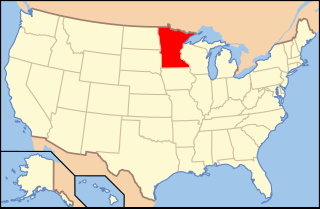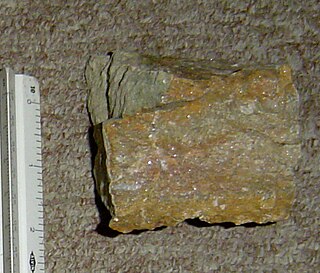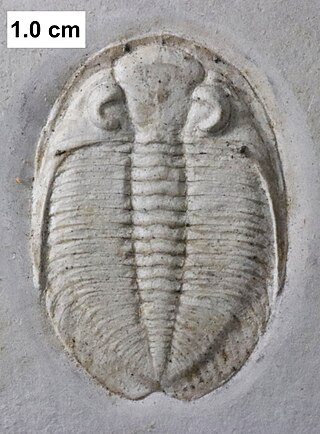
The UW–Madison Geology Museum (UWGM) is a geology and paleontology museum housed in Weeks Hall, in the southwest part of the University of Wisconsin–Madison campus. The museum's main undertakings are exhibits, outreach to the public, and research. It has the second highest attendance of any museum at the University of Wisconsin–Madison, exceeded only by the Chazen Museum of Art. The museum charges no admission.

The Laramie Formation is a geologic formation of the Late Cretaceous (Maastrichtian) age, named by Clarence King in 1876 for exposures in northeastern Colorado, in the United States. It was deposited on a coastal plain and in coastal swamps that flanked the Western Interior Seaway. It contains coal, clay and uranium deposits, as well as plant and animal fossils, including dinosaur remains.

Paleontology in Wisconsin refers to paleontological research occurring within or conducted by people from the U.S. state of Wisconsin. The state has fossils from the Precambrian, much of the Paleozoic, some a parts of the Mesozoic and the later part of the Cenozoic. Most of the Paleozoic rocks are marine in origin. Because of the thick blanket of Pleistocene glacial sediment that covers the rock strata in most of the state, Wisconsin’s fossil record is relatively sparse. In spite of this, certain Wisconsin paleontological occurrences provide exceptional insights concerning the history and diversity of life on Earth.

Paleontology in Minnesota refers to paleontological research occurring within or conducted by people from the U.S. state of Minnesota. The geologic record of Minnesota spans from Precambrian to recent with the exceptions of major gaps including the Silurian period, the interval from the Middle to Upper Devonian to the Cretaceous, and the Cenozoic. During the Precambrian, Minnesota was covered by an ocean where local bacteria ended up forming banded iron formations and stromatolites. During the early part of the Paleozoic era southern Minnesota was covered by a shallow tropical sea that would come to be home to creatures like brachiopods, bryozoans, massive cephalopods, corals, crinoids, graptolites, and trilobites. The sea withdrew from the state during the Silurian, but returned during the Devonian. However, the rest of the Paleozoic is missing from the local rock record. The Triassic is also missing from the local rock record and Jurassic deposits, while present, lack fossils. Another sea entered the state during the Cretaceous period, this one inhabited by creatures like ammonites and sawfish. Duckbilled dinosaurs roamed the land. The Paleogene and Neogene periods of the ensuing Cenozoic era are also missing from the local rock record, but during the Ice Age evidence points to glacial activity in the state. Woolly mammoths, mastodons, and musk oxen inhabited Minnesota at the time. Local Native Americans interpreted such remains as the bones of the water monster Unktehi. They also told myths about thunder birds that may have been based on Ice Age bird fossils. By the early 19th century, the state's fossil had already attracted the attention of formally trained scientists. Early research included the Cretaceous plant discoveries made by Leo Lesquereux.
The Maquoketa Formation is a geologic formation in Illinois, Indiana. Iowa, Kansas, Minnesota, Missouri, and Wisconsin. It preserves mollusk, coral, brachiopod and graptolite fossils dating back to the Darriwilian to Hirnantian stages of the Ordovician period.
The Java Formation is a geologic formation in Kentucky, New York, Ohio, Pennsylvania, Tennessee, Virginia, West Virginia. It preserves fossils dating back to the Devonian period. The formation comprises the Pipe Creek Shale, Wiscoy Sandstone Member in New York, and Hanover Shale Member except in Tennessee.
The Dresbach Formation is a geologic formation in Wisconsin. It preserves fossils dating back to the Cambrian period.

The Jordan Sandstone is a geologic formation in Wisconsin. It preserves fossils dating back to the Cambrian period.
The Trempealeau Formation is an Upper Cambrian geologic formation in Wisconsin. It contains graptolites.
The Lake Church Formation is a geologic formation in Wisconsin. It preserves fossils dating back to the Devonian period.

The Fort Atkinson Formation is a geologic formation in Wisconsin. It preserves fossils dating back to the Ordovician period.
The Waukesha Dolomite is a geologic formation in Wisconsin. It preserves fossils dating back to the Silurian period.
The Byron Formation is a geologic formation in Michigan and Wisconsin. It preserves fossils dating back to the Silurian period.

The Brandon Bridge Formation is a geologic formation in Wisconsin. It preserves fossils dating back to the Silurian period, including those of graptolites, conodonts and Parioscorpio.
The Mayville Formation is a geologic formation in Wisconsin. It preserves fossils dating back to the Silurian period. It is the principle cliff-forming unit in the Niagara Escarpment.
The Windrow Formation is a geologic formation in Minnesota named after Windrow Bluff on Fort McCoy, Monroe County, Wisconsin. It preserves fossils dating back to the Cretaceous period.

The Viola Formation is a geologic formation in Oklahoma. It preserves fossils dating back to the Ordovician period.
The Dawson Arkose is a geologic formation in the Denver Basin that underlies the Denver area in Colorado. It is characterized by alternating beds of arkosic sandstone and mudstone. The Dawson Arkose contains plant remains and other nonmarine fossils, and hosts aquifers that are important sources of water for the area.

The Maroon Formation is a geologic formation in Colorado. It preserves fossils dating back to the Permian period. It is the primary formation of sandstone that lends the vivid red color to the hills around Glenwood Springs, Colorado.
The Alamosa Formation is a geologic formation in Colorado. It preserves fossils. The formation was deposited by Lake Alamosa, a paleolake that existed from the Pliocene to the middle Pleistocene.








